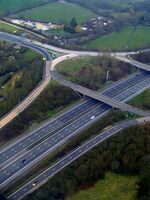Unbuilt Services On The M23
For a list of current service areas on the M23, see Services on the M23.
The M23 is the poster boy for all roads that were only ever half built. After less than 16 miles and having counted down only as far as junction 7, four lanes of motorway disappear shamefully into woodland just south of Hooley.
How do you plan service stations for a motorway which doesn't exist? In the 1960s, planners worked on the basis that the motorway would be going all the way to Streatham Vale, and possibly even to Balham.
They decided upon a two-stop strategy for the M23. You can see the full length intended for the road on SABRE Maps.
Woodmansterne
The thinking at the time was still that service areas close to London would be well-used, especially by HGVs. It later turned out that service areas would profit most from leisure travellers, and there wouldn't be much custom from them this close to London. This motorway service area would have been especially short of leisure traffic, seeing as the motorway wasn't built.
Woodmansterne services would have been positioned between J6 and J7, making it slightly further out than Heston. It was planned to have a large restaurant, with seating for 600-800 people. About eight months was spent arguing the case for it, as local resistance was expected to be strong.
The site was confirmed in 1969. Even then, it was acknowledged that the motorway wouldn't be built "for many years", so the plan for Woodmansterne services sat permanently on the back-burner.
Prior to the backing being given for Woodmansterne, the consultant's report for the M23 took a brief look at the issue of service areas. It was under the impression that one service area should try to cater for the M23 and the M25, and it recommended "a pleasant site" in the valley between Merstham and Hooley. It is hard to see this having ever been incorporated into the M23 safely.
Shipley Bridge

If you were to strictly adhere to government policy, then another service area would be needed about 15 miles south of Woodmansterne.
This took us to the Gatwick area, and a number of potential service area sites were considered here. This included three sites around Shepheard's Hurst (Green Lane) and the Gatwick Airport Roundabout. The name soon changed to Shipley Bridge, which implies a site was chosen either at or to the south of M23 J9.
In 1969, the position was taken that Shipley Bridge was already quite close to the large site planned for Woodmansterne, but it was also very close to the existing facilities already available on the A23 south of Crawley. Surrey County Council were also strongly opposed to it. It was therefore removed from the programme.
Shipley Bridge did have a scheduled opening date of 1974, suggesting it was initially intended to open as part of the motorway scheme.
With no chance of Woodmansterne ever being built, you may think that the time had come to put Shipley Bridge back on the cards. It may have been considered, but updated government policy said that motorways as short as what was built for the M23 don't need any service areas. Forte eventually identified a gap when they built Pease Pottage, but that was arguably more about replacing facilities they had lost on the A23.
Harps Wood
This wasn't really a serious proposal for the M23, but it's worth considering anyway.
When possible locations for a service area on the M25 were examined, Surrey County Council were very keen on building at the interchange where the M25 meets the M23. Most positions were impractical.
In 1983 Tandridge District Council, who were strongly opposed to building Clacket Lane, suggested that the land which had been reserved to complete the M23 be turned into a motorway service area instead. This meant traffic on the M25 would have been directed up the M23, where a service area would have been provided in the middle of the road.
Unsurprisingly, the official M25 study ruled that a service area here would fail to serve the M25, and that its entrance would be confusing.